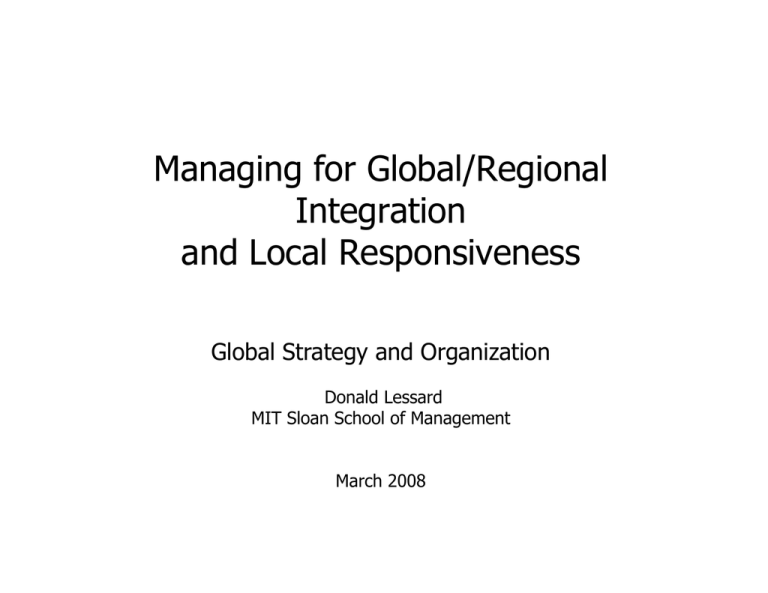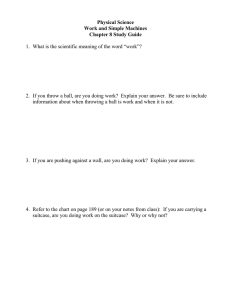Managing for Global/Regional Integration and Local Responsiveness Global Strategy and Organization
advertisement

Managing for Global/Regional Integration and Local Responsiveness Global Strategy and Organization Donald Lessard MIT Sloan School of Management March 2008 Local Global Configuration Global Integration Low High Coordination Local Global Firm-level Frameworks Low High Local Responsiveness Integration-Responsiveness •Integration •Standardization •Coordination •Sharing of BP Global Integration Low High Two dimensions or one? Increasing complexity/effort Low High Local Responsiveness •Differentiation to match local tastes, channels •Responsiveness to interests •Embeddedness to learn •Embeddedness to influence •Stick to Dell model Global Integration Low High I-R for Dell China Wait for market Franchise agents Local dist’n Low High Local Responsiveness •Adapt to local circumstances Response to Lever Skip • How should P & G respond to the Lever Skip Micro initiative in France? • To what extent does your proposed response challenge the Eurobranding approach? Stay the course P & G should launch the product as planned while carefully watching the Lever Skip Micro initiative. (Mirza Ahmed, Barry Bunn, Masahide Kawakami, Hyunyoung Kim) …Lever’s product quality is not as good as P&G, thus P&G should avoid direct comparability to Lever’s product with either package size or price. Based on this approach, P&G should launch Ariel Ultra in two sizes, … P&G should focus marketing differentiation based on environmentally friendly formulation and the ability to get substantially more wash loads ... Pricing should remain at a slight premium as compared to the Lever product. Country specific adjustment off of the regional base price would be at the discretion of the local marketing team. Future launches should occur in a more simultaneous mode. Waltz, Masaaki Yajima, Hidenobu Mukai) (Brent Skip Lever --Issues and Responses Perspective Local Euro Phosphates Use where allowed Eliminate Timing of launch Local convenience All at once Price Locally determined Common structure Package size Locally determined One for all Impact on Lever Match locally Match regionally Issue Underlying Questions for P&G Case • What are the benefits of a (unified) pan-European product/brand? • What are the drawbacks? • Which elements of the product/brand benefit most from a Pan-European approach, which least? How integrated is European Market? We will utilize the CAGE framework Application of the Lessard radar chart Cultural Sensitivity: Environmental reveals: considerations were the primary issues driven 1. A desire by P&G management to take by culture.. advantage of scale/scope – though these Administrative Sensitivity: Organizational synergies are not quantified structure measures and incentivizes GM by the 2. Significant differences in local profits of their local country sales. country regulations (e.g. 4 France has no Geographic Sensitivity: The European anti-phosphate laws, West Germany does) strategy of marketing a consistent product 3. Significant differences in local across all local markets ignores the local markets (e.g. significant differences in product needs and preferences of each wash temperatures, powder/liquid balance, country. Levels of phosphate, perfume, package size preference) packaging size, and other product attributes 4. Some question about comparative need to be tailored to each local market. advantage (How much better are the P&G Economic Sensitivity: The willingness to pay brands in France vs. Lever when the in each country is different. P&G strategy of a market shares are within 3 percentage consistent premium of 15% above their points of one another). standard brand price allows for flexible pricing …relatively small area of the radar for each country. chart The pan-European initiative attempts to commoditize the product. The one size fits all argument does not make sense here. (Dawood Mohammed Al-Dawood, Mikko Uusitalo, and Mark Gustafson) More “coordination” In the future releases of the Ariel Ultra or other products should be better coordinated between counties to reduce the time between releases. .. After this incident with Ariel Ultra, the GMs should see the benefit of cooperating to release the product on a tight schedule since they will be significantly affected by the reaction and increase in work needed to repackage the release. (Justine Li, Rohit Kashyap, Steven James Martin, and Virgil Chan) More “adaptation” P&G should adjust its European brand strategy and allow local adoptions in its marketing mix. The European brand building strategy is lacking the local adaptation required to achieve market leadership and is out performed by its competition. (Wang Tien-Chen, Joerg Hermann Walter Sommer, Ravshan Djeyenbekov, Soo Jin Chun) ..should understand what functions can be centralized and what cannot be. Core competitive activities such as research and development, product formulation, and competitive positioning should be made in a more centralized mode. Market specific activities such as product package sizing and pricing, should be made in a country by country basis to adjust for specific customer’s behavior, competitive situation, and distribution structure. (Brent Waltz, Masaaki Yajima, Hidenobu Mukai) Process We believe that P&G did not manage well the Ariel Ultra innovation process because it did not understand the difference between regional integration and national responsiveness. The project leaders (Meyer and Mancel) were committed to a personal agenda of proving the new Euro-brand organization by rolling out a single formulation, packsize range and pricing across the whole Europe. 'Integration' seemed a noble idea, but poorlyserved in the marketing function with a one size fits all approach which blindly ignored relevant local consumer differences. Their beliefs were challenged when Unilever launched Skip Micro in France, a country which Meyer was also responsible for… (Amy Schumacher, Clara Pombo, Teck Heng, Luis Prata) We were are all uncomfortable with the internally focused nature of this discussion (e.g. one product formula = more leverage/lower costs vs. our customers will be trying to wash this way in the future, here are some ways we might help our customers to that). We didn’t like the lack of customerfocus in these discussions and we were disappointed with what we view as a repeated and limited understanding of the power structure of the firm (e.g. Sub GM’s were powerful, less involved, and motivated to avoid risk). Determine what customer problem needs to be solved, then organize about solving that problem – which we admit is a messy problem .. (Devon Kinkead, Juan Carlos Munoz, Toshi Kajino, Shuey (Shuichi) Yokoyama, Fernando Diarte) Euro Segmentation • How do you get a customer focused discussion that does not automatically segment by country? • Dimensions – Green – Urban vs Hyper – Price vs. performance • Conversion vs. Flanker – Flanker strategy with 2 (even 3) sizes of Ariel Ultra, existing sizes (perhaps trimmed) of Ariel – Can fully convert in some places • Need to have regional level incentives to get there P & G Evolution • 1948: Overseas Division most value added at home, most direction from home, most innovation home for home (profits by country) (Europe, LA) • 1950’s-60’s: Replicating Multi-domestic value-added localized, local org’s and processes “copy-exact” (profits by country) (Asia) • 1980’s: Redundant Multi-Domestic value-added deeply localized, many redundant activities, limited diffusion (profits by country) • Mid-1980’s Regional coordination of functions, brands (profits by country) • 1989 Global Category Executives for strategy, technology, product development (profit by countries) • Mid 1990s – frustration, slowdown in innovation, slow diffusion, limited adoption of “outside” ideas. • 2005: GBUs on top (including profit responsibility), MDOs to implement, functions in GBS. • 2006 – back to the future Written Assignment # 2: Due March 10 • Using one or more of the frameworks presented in class, discuss how your firm (or a firm of your choice) is organized in a particular country/region in order to exploit or enhance its core (often home-based) competencies (RATs description in CEMEX article may be useful here). – Focus on a single business and a single country or region other than the home base. – Describe the whether the country in question is a global/ regional platform, or a local market or source for the firm. (Ferdows' classification may be useful here) – Briefly assess the contribution to the firm's global (regional) competitiveness of the conditions (Porter-'s resource diamond or my extended virtual diamond) of the country/region in question. (this may repeat part of your analysis in Paper # 1) – Describe the nature and degree of global integration and local responsiveness/ embeddedness of (the focal unit of) your firm, using the Bartlett-Ghoshal global integration-localization chart (or another framework that fits the situation better). • To put in context, you might "map" a series of businesses in first I-R grid, but only "explode" one. Do the same with activities and regions. If possible, provide some historical context and compare and contrast the integration and localization of this unit with other units of the firm and/or competitors.







